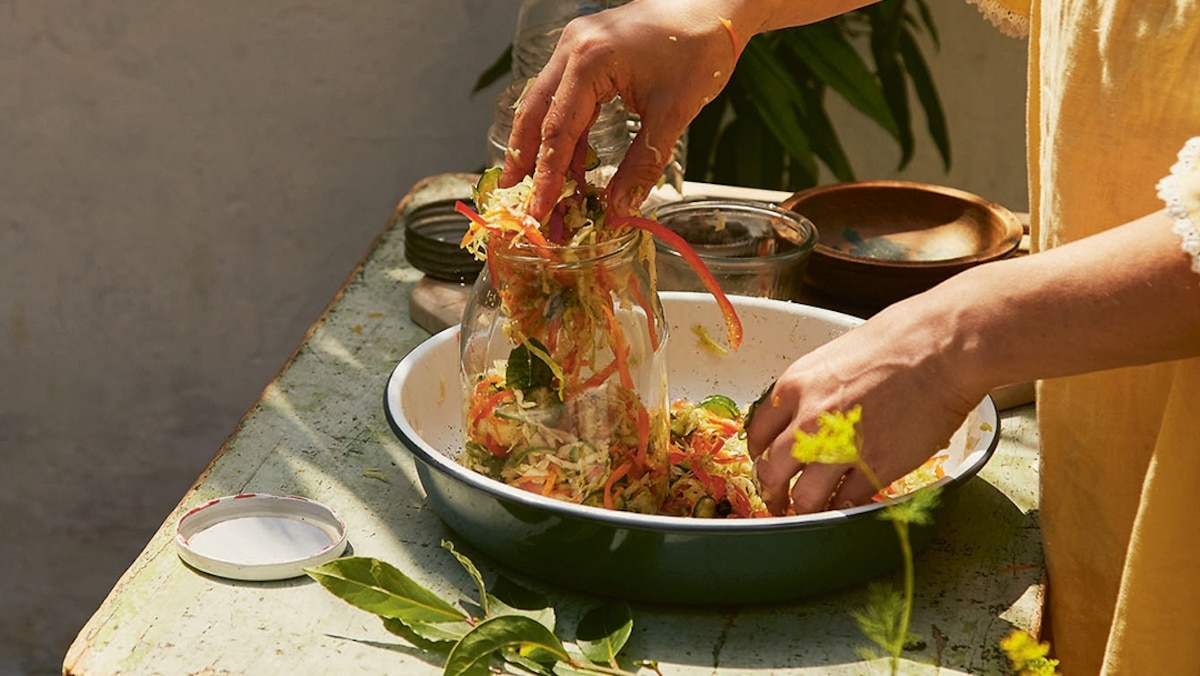Now Reading: Alissa Timoshkina on why Eastern European food is about more than cabbage
-
01
Alissa Timoshkina on why Eastern European food is about more than cabbage
Alissa Timoshkina on why Eastern European food is about more than cabbage

This article was produced by National Geographic Traveller (UK).
How would you define the cuisine of Eastern Europe?
The tradition of sharing food around the table with multiple generations and passing on stories through recipes is at the heart of Eastern European cuisine. There’s also a sense of diversity across cultural and ethnic groups.
In terms of specific dishes, techniques and ingredients, fermentation spans the region. Pies are a simple way of making the most of a few ingredients. And there will always be some form of dumpling. Sour cream is used for stirring into sauces or soups and for dipping dumplings, fritters or pancakes. In summer, there’s an abundance of herbs — dill, parsley, coriander — and lots of simple but fragrant spices like caraway, fennel seeds and black pepper.
How did your upbringing shape your relationship with food?
I grew up in Omsk, Siberia, in the 1980s and 1990s, and I remember endless food queues. It’s nothing compared with what previous generations went through, but it was still a difficult time economically for a huge chunk of Eastern Europe and Russia. Life revolved around finding food, cooking food and making the most of what you had.
Back then, several generations would live in one flat. That created magical moments of having lots of people around, especially in the kitchen. I had three generations living under one roof and cooking for me. That gave me first-hand experience of almost 100 years of Eastern European history, all of which was represented in different dishes.

The Dormition Cathedral is a popular monument in Alissa’s hometown of Omsk in Russia.
Photograph by Zoonar GmbH, Alamy

Beetroot and plum twarog cheese is a bright celebration of Slavic dining heritage.
Photograph by Lizzie Mayson
What were your biggest influences when writing your second cookbook?
The starting point was the war in Ukraine, which pushed me to revisit my family identity. Until recently, I called myself Russian because that’s where I grew up. But my family is Ashkenazi Jewish, Ukrainian and Belarusian, then further down the line, there’s some Polish heritage. It’s very much about seeing that complexity — Eastern Europe is a fascinating place from a historical perspective. Different regimes come and go, borders collapse and new countries and sovereign states are formed. Food is the most powerful and relatable language to explore this history through.
How has the region’s history shaped individual countries’ culinary traditions?

Kapusta: Vegetable-Forward Recipes from Eastern Europe, by Alissa Timoshkina (£28, Quadrille)
Photograph by Alissa Timoshkina
It’s like a mosaic that keeps shifting depending on which historical period or angle you look at it from. The Soviet government had a clear idea of how to use food to implement the notion of Soviet identity. Its dream house was without a kitchen; you’d have a private home, but then communal dining spaces. In the 1930s, the minister of foreign trade went to the US to learn about mass food production. A lot of mayo salads date back to the 1930s, and meat patties inspired by American fast food, though Soviet canteens would use more bread because there wasn’t a lot of meat available.
Going further back, the Ottoman Empire also breaks the borders. Suddenly, we have a lot of Mediterranean dishes, similar to Moldova and parts of Romania. In more southern parts of Eastern Europe like Bulgaria and Ukraine, you find filo pies filled with salty, crumbly brynza cheese, similar to Turkish and Greek feta pies.
Then there’s the central European influence in the Czech Republic, Slovakia and parts of Hungary, where you’ll find strudels and dishes we associate with German or Austrian cuisine. It’s beautiful how these little details open the door to a fascinating history behind the dishes.
What inspired you to name the book after cabbage?
Kapusta means cabbage in many Eastern European Slavic languages. When I studied in the UK, I would always be faced with some form of ‘all you eat over there is cabbage’. I internalised that and felt embarrassed, but the older I got, the more fascinated I became with my region’s cuisine. I felt it was time to turn this cliche on its head. Kapusta has accompanied Eastern Europeans through the most unimaginable hardships. The more I thought about it, the more it became a symbol of the defiance and endurance of their spirit.
Published in Issue 27 (spring 2025) of Food by National Geographic Traveller (UK).
To subscribe to National Geographic Traveller (UK) magazine click here. (Available in select countries only).






















